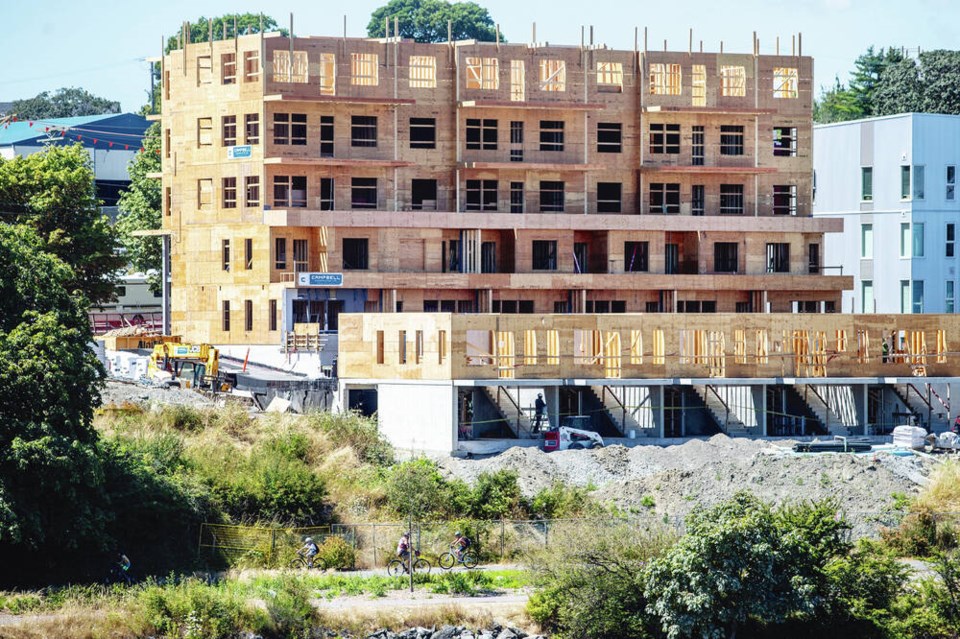I come now to the fifth and final ‘Big Idea’ from Livable Victoria, a group of which I am a member. As a group we are passionate about what it takes to create a more sustainable, vibrant, healthy, and equitable place to live. The first four ‘Big Ideas’ have dealt with broad issues of socially just housing policy, fair and ecologically sustainable urban and neighbourhood design, and active transportation. This fifth one deals with the design, construction and operation of the buildings themselves.
In North America, we spend on average 90 per cent of our time indoors. So the design and operation of the immediate built environment where we spend the vast majority of our time is of great importance for our wellbeing.
That, of course, is why we have building codes; it’s all about safety and health. The B.C. Building Code establishes “minimum requirements for safety, health, accessibility, fire and structural protection of buildings, and energy and water efficiency.”
The built environment not only affects our wellbeing directly, because we live within it, but indirectly, by impacting on the wider environment, which in turns affects us. Energy use in buildings is particularly important because buildings have a large ecological footprint, with carbon emissions forming a large part of the footprint, and we need to reduce both materials use and fossil fuel energy use.
City of Victoria Mayor Lisa Helps said this week that “buildings account for nearly half of all greenhouse gas pollution generated in the city.” When the One Planet Saanich team estimated the overall ecological footprint of Saanich they noted that for the built environment “nearly three-quarters of footprint impacts are due to operating energy (electricity and fuel used for heating)”, while “the remaining quarter is due to the energy and materials … used to construct the buildings.”
So our fifth ‘Big Idea’ is to minimise building waste, energy consumption and greenhouse gas emissions. Accordingly, we recommend not just requiring that buildings be energy efficient, but actually incentivizing building designs that reduce energy consumption and embodied carbon. For example, municipalities and the province should provide incentives for high-performance walls, renewable energy production (e.g., solar panels), low-carbon concrete and bio-based construction materials.
To support this shift in construction practices, which is already underway, we recommend a collaboration between industry, academic and government partners to build local knowledge and capacity on sustainable building practices such as working with low-embodied carbon materials, and zero-waste practices. Could this be a role for the recently announced continuing education campus in Langford?
In addition, we recommend that households should be incentivized to upgrade fossil fuel heating and hot water systems with energy-efficient electric systems. In fact, just this week, the City of Victoria has done that, requiring almost all new buildings constructed after 2025 be “zero-carbon,” which rules out fossil fuels for heating and cooking. The rest of the region should follow their lead, indeed Saanich and Central Saanich are reportedly considering this.
Another key recommendation is to implement strict requirements to minimize landfill waste from building demolitions and construction while incentivizing material reclamation whenever possible. This is because “material from the construction sector represents more than one-third of Victoria’s landfilled waste,” states the City of Victoria.
Hence the city’s new demolition waste and deconstruction bylaw, passed in June. In an interview with the local CTV News, Adam Corneil, founder and CEO of Unbuilders Deconstruction, noted that “90 per cent of the materials salvaged from a construction site are either resold, donated or recycled, keeping them out of the landfill.” Other municipalities should follow suit.
The 5 Big Ideas from Livable Victoria that I have presented in these five columns “aim to create a city that respects our planet’s ecological limits while promoting human health and wellbeing.” They are meant to be implemented as a whole, as they reinforce each other, and are “intentionally designed to be flexible and not overly prescriptive,” so that creativity and innovation can flourish.
We hope they will become a central part of the discussions in the coming municipal elections about how to create a more livable region not only for today’s residents, but future generations who make Greater Victoria their home.
Dr. Trevor Hancock is a retired professor and senior scholar at the University of Victoria’s School of Public Health and Social Policy.
>>> To comment on this article, write a letter to the editor: [email protected]



